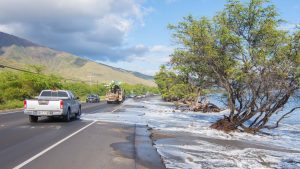Between a rock and a hard place: Coastal erosion and climate change
Posted on Apr 27, 2022 in Capitol Connection, Featured, MainThe scene was shocking enough: a home on O‘ahu’s North Shore collapsed onto the beach. But with coastal erosion threatening more homes and roadways in Hawai‘i, the question is, “What can we do about it?” The answers, according to Suzanne Case, director of the Department of Land and Natural Resources, are hard to come by for both homeowners and the state.
“There’s a whole stretch of homes that are in big trouble right now in that area,” said Case, who surveyed the damage firsthand. “We’re going to be seeing more and more of this with sea level rise.”
What is DLNR’s advice to homeowners? “For now, we’re trying to help people buy time while they figure out what to do with their house,” she said. “A lot of the homes on shorelines were built without the proper setbacks decades ago,” said Case. “Now we have this problem, but the state can offer only limited temporary help for private beachfront owners while we also protect the public beach.”
To sound the alarm about sea level rise, the Ige administration’s Climate Commission produced the first-ever statewide threat assessment for rising coastal waters in the 2017 “Hawai‘i Sea Level Rise Vulnerability and Adaptation Report.” It includes inundation maps for every island based on a projected 3.2 feet of sea level rise by the end of this century. Other agencies are examining strategies to deal with coastal hazards, including elevating structures on piles, protection such as seawalls (which can do their own damage to beaches), and beach nourishment that includes moving sand.
“Managed retreat” is the most complex adaptation strategy since it would involve both public and private properties and multiple county, state and federal agencies. The state Department of Transportation is already developing a plan for coastal highways in some already threatened areas on Maui and O‘ahu.
“But what do you do with an area like Waikīkī?” Case said. “Some countries are armoring their shorelines. Some are moving their whole nation to another continent. Managed retreat is going to be a slow, expensive site-by-site process. The questions are what is practical, what will last?”
That’s why DLNR and the Ige administration have focused on ways to fight climate change and slow down sea level rise in the long term, even as they try to address issues in the short term. Through the Sustainable Hawai‘i Initiative, the state is taking action to reduce greenhouse gas emissions and asking everyone to do what they can to conserve the planet’s resources.
Read more in the May Capitol Connection newsletter.
Subscribe to the Capitol Connection newsletter.

